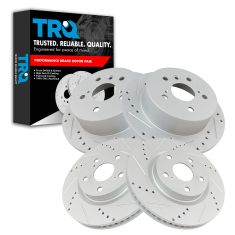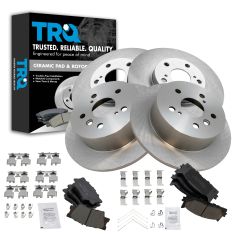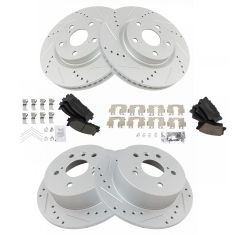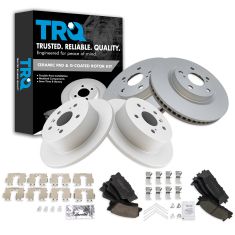1APBS00028-Toyota Lexus Front Ceramic Performance Brake Pad & Rotor Kit TRQ Performance BKA12058
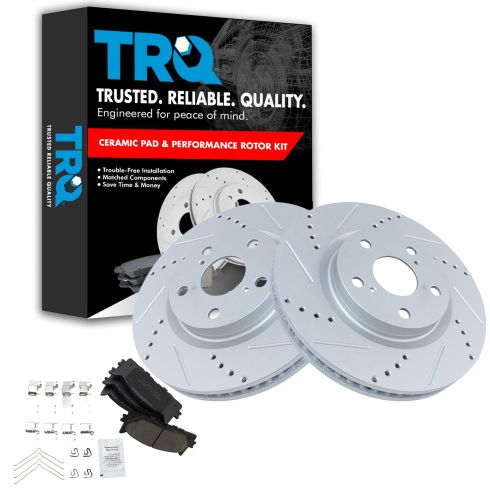
Replaces
2016 Toyota Avalon Front Ceramic Performance Brake Pad & Rotor Kit TRQ Performance BKA12058

Product Reviews
Loading reviews
4.56/ 5.0
32
32 reviews
Nice rotors!
March 13, 2017
My wifes Lexus ES350 was having a bad shaking when stopping, I recently intalled a full set of Nakamoto rotors and pads and they are excellent + they give a sporty look to the car!! By the way all shaking is gone!!!
Great value
November 29, 2017
This brake kit solved my problem ,which the dealer was unable to fix.
Performance and looks enhanced
April 2, 2018
Brake kit with slotted rotors really helped enhance the brakes on my 2013 Toyota Camrey. Both performance and looks were improved.
Brakes are great
August 8, 2018
This is my third or fourth time using 1aauto. Always satisfied and impressed with quality and customer service.
Looks better than the original equipment
August 24, 2018
These rotors fit like the original but look so much better. The brake pads match the originals exactly. I would recommend these to anyone that wants to improve the appearance and braking.
Front Brake Kit for a 2014 Camry
September 26, 2018
Not too long after installation of this brake kit, I took a long trip to visit relatives. Braking was very smooth with very good stopping performance. I would definitely buy another kit like this in the future.
Parts
April 12, 2019
Quick delivery and good price
Good
December 22, 2019
Box was destroyed maybe better packing next time missed a couple clips overall good deal and fast shipping
Very satisfied with my purchase!
March 6, 2020
First time that I opt in getting ceramic brakes and I couldn't be happier. I have already used these brakes for about 500mi with no issues. Everything you need is included in the box. Would definitely trust 1A Auto again whenever I need brake parts. Thank you!
Like new
April 18, 2020
Very pleased with the way they fit. The how to video explained step by step and made easy to feel comfortable changing the brakes. Overall product is exactly like the old including the clips and there was enough grease to do both sides. Rotors are heavy duty and were an equal match to the old ones. Will definitely plan on getting the same set for rear. Unmatched by these auto parts which wanna sell you what you don't need.
Great Set
November 19, 2020
I would totally recommend this set. The pads bite really nicely. Way better than the OE brakes from Toyota. I also like the slotted/drilled style, and the feeling you get when you stop. You can feel when the pads heat up to their operating temperature and really start biting. 10/10 so far.
Brake replacement and rotor replacement on 2014 Camry.
April 23, 2021
From start to finish from order to completion everything was so smooth. The video was super helpful. Could not ask for a better alternative to overpriced dealership maintenance. I saved so much money.
Thank you A1 auto
Well done
August 1, 2021
Fast and great service. Well pleased. customer service was outstanding.
Slotted and drilled rotors with ceramic pads.
December 14, 2021
They preform just like any other rotor and pads. I never had an issue.
Not good
December 30, 2021
Changed my brakes and rotors on my 2017 Camry Se and nothing but squeaking and grinding
Smooth stop
January 21, 2022
Great brakes..fast delivery
Excellent for the commuting car
February 11, 2022
Installation was easy and fit is excellent. Braking performance is also excellent. Much better than the OEM parts.
Good value, mediocre pads, more noise than stock
February 26, 2022
Good Value. A bit disappointed in the pads. I did a brake bed in right after install and the brake fade was horrible. I thought I had air in the lines or I was going to have to swap the pads to something else. After they cooled off a bunch of powered material was liberated and left a trail of dust in my garage when I took it out for the next drive. They were pretty solid on the next drive with no changes, although I did not push super hard on them. They do make more noise than stock during hard braking, pretty sure it is the slots in the rotors. Overall it meets my needs.
March 6, 2022
They look & work great.
Good package
April 6, 2022
Very good product will buy again
May 24, 2022
Good fit great value!
Great service and arrived on spot
June 22, 2022
So far so good, looks and feels like good quality
Test trial
November 19, 2022
I dont know if it was the job being done or the product but I ordered these got both sides replaced both brakes are good but rotors are questionable I can still feel them when slowing down I feel slight vibration on driver side they look good and passenger side is good
Satisfied customer
November 22, 2022
Working great fast delivery.
Rotor and brake kit from 1A Auto
April 30, 2023
Perfect fit rotor and hardware, easy installation everything fit with no issue at all, smooth ride over all all the vibration when I was breaking with the after part from the local auto store stopped soon as I installed 1A Auto product loving it 100% thx.
Brake pads make nosiness!
June 9, 2023
They are ok not best but I can't complain for the price ! The brake pads make some noise..
No more brake shuddering
August 16, 2023
The brakes on my Camery were shuddering when applied coming down a hill. Replaced the rotors and pads with the TRQ Ceramic Performance kit. Came with everything I needed and installed without issues. Brakes no longer shudder and stopping is nice and smooth. Would purchase again and recommend to other Camery owners.
Fast service and great parts.
August 17, 2023
I am very happy with 1A Auto. The parts were delivered very quickly and they were installed with no problems. I will be ordering more parts soon so I can get some additional work finished before the snow flies.
Excellent
October 20, 2023
Upgraded to the drilled and slotted rotors stops much better than the flat surface
Glad I purchased them!
March 12, 2024
My mechanic recommended them...I liked the price and track record he's had with them. I've only had them installed for a short time, but so far, so good!
2015 Toyota front brakes
August 25, 2024
Everything fit great and all installed easily.
September 20, 2024
Great quality
Customer Q&A
Rotors made in USA or China? Are rotors dynamic balanced?
January 14, 2016
10
Hello, We have a few different manufacturers for these items. They are generally made over seas. These are upgrade rotors, and do come with a lifetime warranty!
January 27, 2016
Derek C
10
Good quality, balanced well
August 27, 2017
Dustin R
Are these pads and rotors ok to use in a hybrid Camry?
March 11, 2017
10
Hi Ben! I just installed a full set to my wife's Lexus ES 350 and they are great and gives the car a more sporty look!!
March 13, 2017
R U
Can these be used on front and back?
May 23, 2018
10
These cannot be used on the rear of my 2014 Camry
May 23, 2018
M T
10
These will only work on the front end.
May 23, 2018
T I
Why not use the slotted drilled rotors if they are better? I have a 2012 Lexus ES350, wondering if I should get the slotted and drilled or the Solid rotor, like OEM?
December 14, 2021
10
Yes, this part will fit your vehicle. Either one will be able to work properly for your vehicle but the cross drilled and slotted parts are performance parts.
December 14, 2021
Emma F
10
I would use the drill and slotted rotors it will cool off fast than solid. Specially under hard braking and less warping. I have them on my car I like them. Also replace the calipers too.
December 15, 2021
Thomas J
Toyota is a registered trademark of Toyota Motor Corporation. 1A Auto is not affiliated with or sponsored by Toyota or Toyota Motor Corporation.
See all trademarks.








